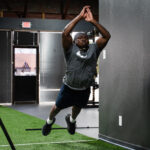How Sports Performance Training Improves Athletic Endurance
Athletes know that endurance is key to success. Whether you’re on the field, court, or track, lasting longer than your competition gives you an edge. That’s where sports performance training comes in.
This specialized training goes beyond general workouts. It helps athletes build stamina, recover faster, and maintain high performance throughout an event. In this post, we’ll explore how sports performance training boosts endurance and why it matters.
What Is Endurance in Sports?
Endurance is the ability to sustain physical activity over a period of time. There are two main types:
-
Aerobic endurance: Long-duration efforts, like distance running or cycling.
-
Anaerobic endurance: Short bursts of high-intensity movement, like sprints or repeated jumps.
Most sports demand a mix of both. For example, soccer players need aerobic endurance for the full match and anaerobic bursts for quick plays.
Sports performance training focuses on improving both, using sport-specific techniques.
Builds a Strong Cardiovascular Base
The foundation of endurance is cardiovascular fitness. Sports performance training includes aerobic exercises like:
-
Interval runs
-
Bike sprints
-
Rowing circuits
-
Tempo runs
These workouts challenge your heart and lungs. As a result, you improve oxygen delivery to muscles, which delays fatigue.
Over time, your resting heart rate drops, and your body becomes more efficient. This means you can perform at a higher level for longer.
Enhances Muscle Efficiency
Endurance isn’t just about your lungs—it’s about your muscles too. Sports performance training helps your muscles use energy better.
This is done with techniques like:
-
Resistance training
-
Plyometrics
-
Bodyweight circuits
-
High-rep, low-weight sets
Improved muscular endurance means you can push harder without getting tired. Plus, it reduces soreness and boosts recovery between sessions.
You’ll be able to sprint, jump, and push off repeatedly without losing strength.
Develops Proper Breathing and Movement Patterns
Athletes who breathe poorly during games tire quickly. Sports performance training teaches correct breathing under stress.
This includes:
-
Controlled breathing during cardio
-
Breath-timed lifting
-
Diaphragmatic breathing drills
Better breathing leads to more oxygen intake, which fuels your performance.
Additionally, training improves your movement patterns. This saves energy and reduces the effort needed for each step, swing, or jump.
By moving efficiently, you conserve stamina throughout the game.
Increases Lactate Threshold
Your lactate threshold is the point where your body starts to fatigue from intense effort. Sports performance training raises this threshold.
With HIIT (High-Intensity Interval Training), you train your body to handle more lactic acid buildup before slowing down.
Workouts might include:
-
Sprint intervals
-
Hill repeats
-
Agility drills with short rest
According to Healthline, interval training is one of the fastest ways to increase endurance.
Higher lactate tolerance means you can perform at top speed for longer—without feeling the burn too soon.
Supports Faster Recovery
Endurance also depends on how quickly you recover during and after play. Sports performance training includes active recovery techniques like:
-
Mobility work
-
Foam rolling
-
Yoga-inspired stretches
-
Low-impact cardio
You’ll also learn to monitor your recovery through heart rate variability (HRV) and rest days. This keeps your body primed to perform.
Faster recovery means you’re ready for the next play, set, or session with less downtime.
Customizes Training for Your Sport
Endurance demands vary by sport. A hockey player needs different stamina than a tennis player or a runner.
That’s why a custom sports performance training plan works best.
Programs are designed based on:
-
Sport-specific demands
-
Game duration and intensity
-
Athlete’s current fitness level
-
Position played (especially in team sports)
For tailored endurance training, Next Level Athletics offers coaching that adapts to your exact needs.
You’ll see faster progress and avoid wasting time on the wrong workouts.
Mental Endurance Matters Too
Let’s not forget mental stamina. Staying focused, motivated, and sharp throughout a game is just as crucial as physical fitness.
Sports performance training includes:
-
Goal setting
-
Visualization techniques
-
Focus drills
-
Positive self-talk training
Mental endurance keeps you calm under pressure and sharp in overtime.
Together with physical stamina, it creates the complete athlete mindset.
Tracking Progress and Staying Motivated
What gets measured gets improved. Athletes in sports performance training track endurance with:
-
Timed runs
-
Heart rate data
-
Repeated sprint tests
-
Recovery times
These numbers show what’s working and what needs attention.
Watching your improvements—like faster sprints or longer sustained effort—keeps you motivated to train harder and smarter.
Conclusion: Build the Endurance to Outlast the Competition
Sports performance training is the key to better endurance. It trains your heart, lungs, muscles, and mind to go the distance. Whether you’re on a team or competing solo, lasting longer means performing better.
From aerobic drills to sport-specific intervals and mental focus techniques, it’s all designed to help you win.
Invest in your endurance, and you’ll see the results in every sprint, set, and season.


Recent Comments